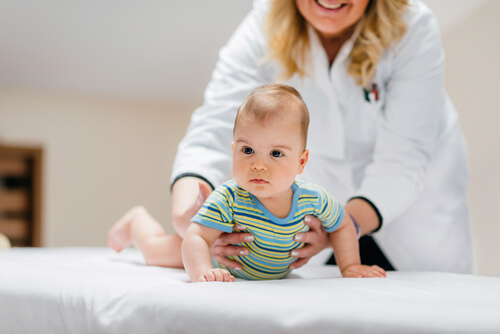Development of the Parachute Reflex

In this article we’ll explain the development of the parachute reflex in babies.
Reflexes in babies are a motor response to certain stimuli. Reflexes are the main feature of a developing nervous system.
These responses in babies usually appear during the first months of life and disappear when the brain is mature.
The most common reflexes are the suckling reflex, the stepping reflex, and the not-so-well-known but equally important parachute reflex.
What is the parachute reflex?
The parachute reflex is a protective response that appears around 5 months of age.
This reflex can be seen when the baby is held under the armpits in a straight position and turned quickly onto his belly, as if thrown on a surface.
The motor response consists of extending the arms to break the fall. This reflex is maintained throughout life.
Why do babies have the parachute reflex?
The parachute reflex is one of our primitive reflexes. These are operated by the central nervous system and favor survival during the first year of life.
The primitive reflexes begin in the womb and develop with the movements typical of each age. Therefore, these reflexes are produced by the action of stimuli from the outside world.
They are involuntary movements that disappear over time.

How to determine if your baby has developed the parachute reflex
The best way to examine the development of your baby’s reflexes is to consult with your pediatrician each month.
However, you can check the baby’s parachute reflex by seeing whether he has the following reactions:
- Lower the child onto an area where his feet and body can rest. Observe an immediate posture of extension and slight external rotation of the legs. It’s easily identifiable by the 5th month of age.
- To observe the lateral parachute reflex, have the child sit so that his legs hang down. Gently push him to one side and watch as he reaches out quickly with his arm to avoid falling. This reflex can be detected by the age of 6 months.
- A frontal reaction can be seen when the child is pushed forward and spreads his arms quickly to protect himself from harm. This level of the parachute reflex is generally seen between months 7 and 8.
- Another protective response occurs when the child is pushed backwards. His arms and wrists extend and the back of his shoulders tilt backward.
Regularly checking the presence of these reflexes in your child will give you an idea about how his motor skills and nervous system are developing.
The best way to examine the development of your baby’s reflexes is to consult with your pediatrician each month.
Absence of reflexes in babies
The absence of multiple reflexes in babies can occur as a result of neurological injury or a weakness in the motor system.
These pathologies are presented with the following characteristics:
- Children who are always lying down and are unable to sit upright.
- Reduced muscle tone that is evident in a lack of coordination, causing the baby to crash, fall and go sideways.
- Difficulty concentrating or focusing his vision, such as when watching television. A complication of this condition includes developing learning disorders by the time the child is of school age.
- Inability to potty train.
- Inability to develop fine motor skills, work with hands or even to eat.
- Babies with nervous, scared or very dependent attitudes.

Timely detection of these conditions may suggest the inclusion of therapies that encourage the development of these reflexes, or the skills appropriate to the child’s age.
An excellent alternative may be the implementation of games and movements that simulate involuntary body responses automatically.
In summary, the presence of reflexes in a baby guarantees correct nervous and motor development.
Being aware of whether they appear and disappear at the correct time should greatly contribute to the health of the child.
In this article we’ll explain the development of the parachute reflex in babies.
Reflexes in babies are a motor response to certain stimuli. Reflexes are the main feature of a developing nervous system.
These responses in babies usually appear during the first months of life and disappear when the brain is mature.
The most common reflexes are the suckling reflex, the stepping reflex, and the not-so-well-known but equally important parachute reflex.
What is the parachute reflex?
The parachute reflex is a protective response that appears around 5 months of age.
This reflex can be seen when the baby is held under the armpits in a straight position and turned quickly onto his belly, as if thrown on a surface.
The motor response consists of extending the arms to break the fall. This reflex is maintained throughout life.
Why do babies have the parachute reflex?
The parachute reflex is one of our primitive reflexes. These are operated by the central nervous system and favor survival during the first year of life.
The primitive reflexes begin in the womb and develop with the movements typical of each age. Therefore, these reflexes are produced by the action of stimuli from the outside world.
They are involuntary movements that disappear over time.

How to determine if your baby has developed the parachute reflex
The best way to examine the development of your baby’s reflexes is to consult with your pediatrician each month.
However, you can check the baby’s parachute reflex by seeing whether he has the following reactions:
- Lower the child onto an area where his feet and body can rest. Observe an immediate posture of extension and slight external rotation of the legs. It’s easily identifiable by the 5th month of age.
- To observe the lateral parachute reflex, have the child sit so that his legs hang down. Gently push him to one side and watch as he reaches out quickly with his arm to avoid falling. This reflex can be detected by the age of 6 months.
- A frontal reaction can be seen when the child is pushed forward and spreads his arms quickly to protect himself from harm. This level of the parachute reflex is generally seen between months 7 and 8.
- Another protective response occurs when the child is pushed backwards. His arms and wrists extend and the back of his shoulders tilt backward.
Regularly checking the presence of these reflexes in your child will give you an idea about how his motor skills and nervous system are developing.
The best way to examine the development of your baby’s reflexes is to consult with your pediatrician each month.
Absence of reflexes in babies
The absence of multiple reflexes in babies can occur as a result of neurological injury or a weakness in the motor system.
These pathologies are presented with the following characteristics:
- Children who are always lying down and are unable to sit upright.
- Reduced muscle tone that is evident in a lack of coordination, causing the baby to crash, fall and go sideways.
- Difficulty concentrating or focusing his vision, such as when watching television. A complication of this condition includes developing learning disorders by the time the child is of school age.
- Inability to potty train.
- Inability to develop fine motor skills, work with hands or even to eat.
- Babies with nervous, scared or very dependent attitudes.

Timely detection of these conditions may suggest the inclusion of therapies that encourage the development of these reflexes, or the skills appropriate to the child’s age.
An excellent alternative may be the implementation of games and movements that simulate involuntary body responses automatically.
In summary, the presence of reflexes in a baby guarantees correct nervous and motor development.
Being aware of whether they appear and disappear at the correct time should greatly contribute to the health of the child.
All cited sources were thoroughly reviewed by our team to ensure their quality, reliability, currency, and validity. The bibliography of this article was considered reliable and of academic or scientific accuracy.
- Cabrera, M.C. y Sánchez C. (1982). La estimulación precoz; un enfoque práctico. Editorial Siglo XXI: España.
- Dorance, S. y Matter, P. (2001). Juegos de estimulación para los más pequeños. Madrid: AKAL.
- Gallahue, D. (1982). Understanding motor development in children. New York: John Wiley and sons.
- Guerrero, A. M., & Primaria, I. Y. (n.d.). La estimulación temprana. https://archivos.csif.es/archivos/andalucia/ensenanza/revistas/csicsif/revista/pdf/Numero_14/AMALIA_MORENO_1.pdf
- Martorella, A. M. (2011). Papel de los reflejos arcaicos del primer mes de vida en el desarrollo de la inteligencia y del aparato psicoemocional. Revista de Psiquiatría Infanto-Juvenil, 28(4), 63-72. https://www.aepnya.eu/index.php/revistaaepnya/article/view/215
- Moreno, J. A. (1999). Motricidad infantil. Aprendizaje y desarrollo a través del juego. Murcia: Diego Marín.
- Moreno, J. A., & De Paula, L. (2006). Estimulación de los reflejos en el medio acuático. Revista Iberoamericana de Psicomotricidad y técnicas corporales, 6(2), 193-206. https://www.um.es/univefd/reflejos.pdf
This text is provided for informational purposes only and does not replace consultation with a professional. If in doubt, consult your specialist.








